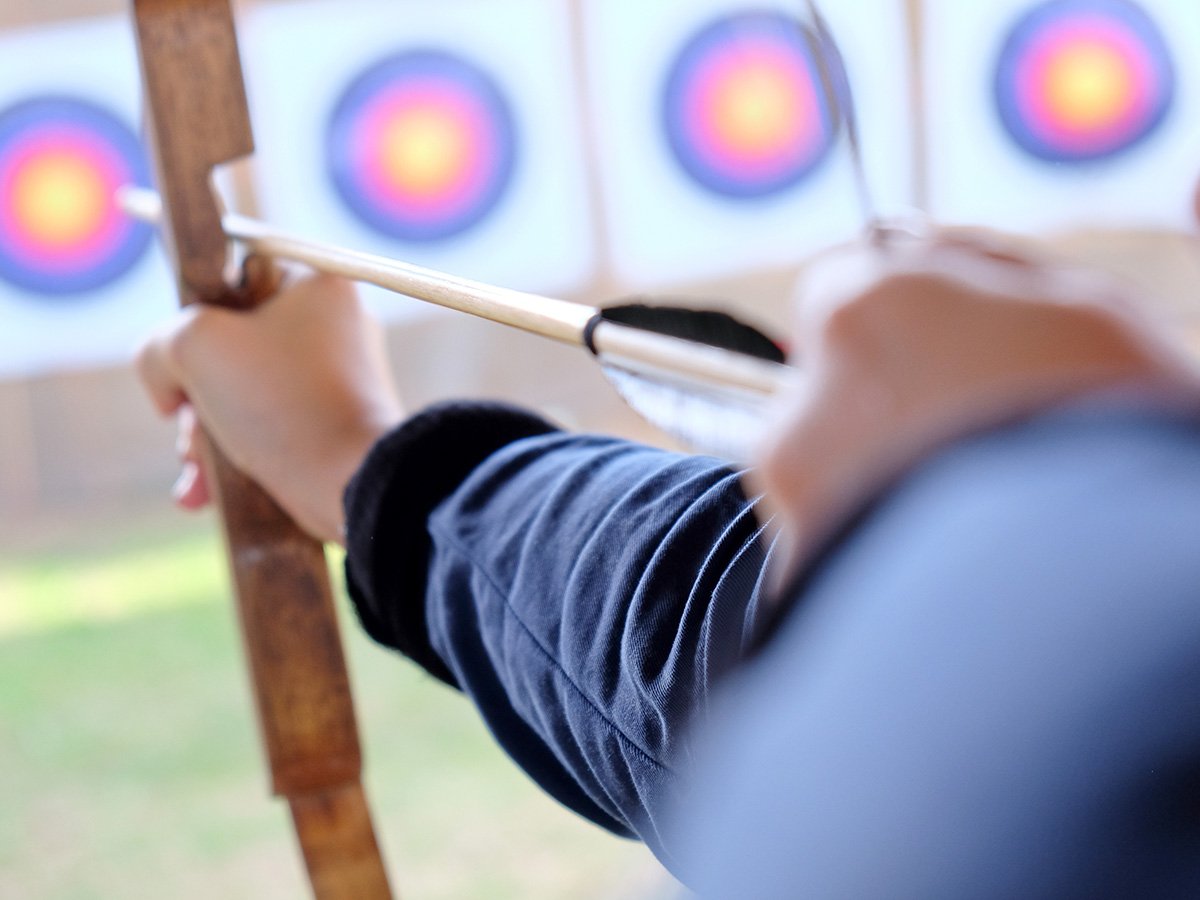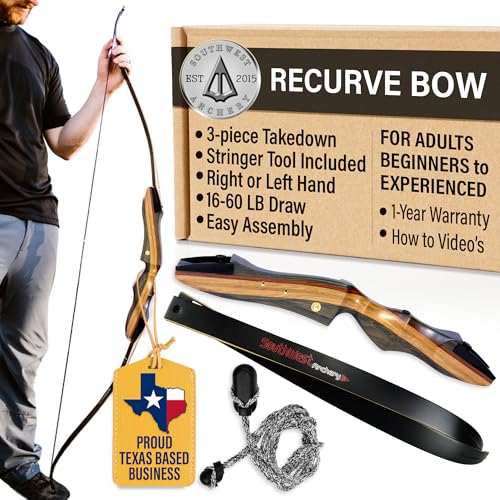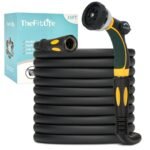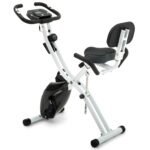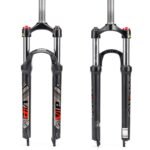The Recurve Bow: The Best Archery Bows For Beginners
We truly believe the recurve bow is the best choice for best archery bows for beginners and a great choice for someone who is just starting out. Most everyone experienced will tell you to start with a recurve bow so that you can develop proper form and be able to shoot more intuitively. For a novice archer, going for the more complicated bows will be very confusing and intimidating. It makes sense to go for the most basic bow.
Our Choices For Best Archery Bows For Beginners
We wanted to give you at least three solid ideas to choose a recurve bow and arrow set on Amazon. We didn’t throw darts to choose. We actually took the time to test these items and we fell in love with all of our choices below. These are our choices for the best archery bows for beginners:
Southwest Archery Spyder Takedown Recurve Bow
This is our favorite choice for a recurve bow set and the best archery bows for beginners. We love this set. If we were starting out again, we agreed this would be our choice. Plus, it’s made in the USA. What’s not to love.
- Choose Your Length– 62″ OR 64″ XL: This Spyder recurve bow is available in two sizes: 62” Standard or 64” XL. Both use the same riser, but the XL version features longer limbs, this is ideal for archers over 6 feet tall or with a draw length over 30″. Perfect for target practice or bowhunting.
- Construction: We’ve combined four naturally sourced woods to create this beautiful compact, accurate, lightweight bow that is the perfect choice for just about anyone looking for an easy to learn bow. The hard edges of the riser and limb pockets have been rounded to provide a sleeker, lighter weight, more ergonomically comfortable experience.
- Wide Range of Draw Weights: Available in both Left and Right Hand, with draw weights from 20lb – 60lb Spyder (62”) & 25lb – 55lb Spyder XL (64”), this takedown recurve bow is great for beginners, intermediate, and seasoned archers alike.Threaded bushings come pre-installed for accessories such as mechanical rests/plungers, sights, quivers, and stabilizers/bow fishing reels
- Fast Flight String Compatible: The fiberglass-laminated limbs feature a maple wood core and reinforced tips, making them compatible with both Fast Flight and Flemish twist strings, delivering speed, performance, and reliability for every shot.
- All-Inclusive Takedown Kit: Includes one riser (LH or RH), a pair of matching limbs, a 14-strand Dacron string, an adhesive arrow rest, stringer tool, and full photo-illustrated instructions. Easy to assemble and ideal for travel & storage.
PANDARUS Wooden Takedown Recurve Bow Set
This is our second favorite recurve bow set. Again, we love this set too and it’s actually less expensive but we still agree that the Southwest Archery Spyder is our true favorite. This set is a little more complete adding more items to the set then the Spyder. So, you can have almost everything in this set.
- 【SPECIFICATIONS】: AMO Length:62” ,Max Draw Length:29″, Bow Riser Length:19.5″ , Draw Weight:20-50LBs, Bow Riser Material:wood ,Both left handed and right handed are available.
- 【PACKING PRO LIST】: 1xPANDARUS Wooden Recurve Bow,1xArrow Sight,1xTarget Paper,1xArrow Rest, 1xBow Stringer,1xFinger Guard, 1xArm Guard, 6xArrows,1xBow String, 1xRecurve Bow Case. Created with removable limbs this bow can also be stored in various ways for easy storage.
- 【ADVANCED CONSTRUCTION 】: The riser is designed with rounded edges and a fine finished handle, making it very comfortable to hold. Lightweight and highly durable bows, with a comfortable ergonomic grip
- 【MATERIAL】: a reliable wooden core and strong fiberglass & wooden limbs, a powerful 16 strands daclon fabric bow string
- 【WARM NOTICE】: Please read the manual carefully before you operate the bow. The bow is for Women,Youth and Beginner as an antry-level compond bow.DO NOT DRY FIRE (shoot the bow without arrow)! This will damage the bow and hurt yourself and the people around you.
TIDEWE Recurve Bow and Arrow Set
We liked the Tidewe set too but we weren’t as thrilled about the quality. Again, the Spyder is the best and is worth the little bit extra you will pay. It will last a lifetime. But if you like some of the features of the Tidwe, we still hold that it’s a great set for someone just starting out with archery.
- 【High Performance】TIDEWE’s recurve bow features a reliable wooden core and strong fiberglass & wooden limbs. In addition, we provide a powerful 16 strands daclon fabric bow string. This way you can focus more on successfully hitting your targets.
- 【Ergonomic & Unique Design】 The riser is designed with rounded edges and a fine finished handle, making it very comfortable to hold. This comfort will allow you to have the best experience shooting multiple arrows or for extending amounts of time. Our design is also appealing to the eye making it unique in its own ways.
- 【Easy to Assemble & Versatility】 This recurve bow is very friendly to put together. While following the easy to read instructions, set up can take less than 5 minutes. Our bow offers pre-installed brass bushings for various attachments and upgrades such as, stabilizers, sight, quiver, and bow fishing reels.
- 【User-Friendly】 TIDEWE’s bow provides multiple accessories, including an arrow rest, finger guard, target, bow stringer, 6 pcs carbon arrows with removable field tips, and more. Created with removable limbs this bow can also be stored in various ways for easy storage.
- 【Size】The TIDEWE recurve bow weighs 2.45 pounds and is 62.00 inches long with a 29.00” max draw length. Draw weight from 20-40lb fits for beginners as well as professionals.
Guide To Help You In Choosing The Best Archery Bows for Beginners
For a long time, the bow and arrows have been the weapon of choice for hunters, archers, and warriors. It’s an iconic weapon that dates back to different civilizations all across the globe. Nowadays, it is still widely used in modern-day hunting and self-defense, as well as in competitions such as Olympic shooting and in recreational settings as well.
Archery newcomers are mostly concerned with the following in the search for the best archery bows for beginners:
- The price range of starter packages and how easy it is to use, tune and maintain
- The amount of practice and time needed to achieve accuracy if one is new to archery
- The draw weight of the bow so it’s not too difficult to shoot for any length of time
- The bow should be lightweight but made of a durable material
This guide will help you to learn the best archery bows for beginners and also beginning archery for adults. But first, we will talk about the various types of archery and the different archery bow types that are best for you when starting bow and arrows. Then we’ll talk about the parts of a bow. Next, we’ll talk about the various measurements needed to pick a bow that fits you best.
Our Choices For Best Archery Bows For Beginners
Spyder Takedown Recurve Bow – Hunting & Target Bow – Fast, Accurate, Versatile – Handcrafted Riser – Fiber Glass Maple Limbs – 62″ Right Hand, 35lb with Stringer ToolPANDARUS Wooden Takedown Recurve Bow 62″ Right Handed for Outdoor Training Practice Recurve Bow for Adult & Youth Beginner (20lbs, Right Handed Pro)TIDEWE Recurve Bow and Arrow Set for Adult & Youth Beginner, Wooden Takedown Recurve Bow 62″ Right Handed with Ergonomic Design for Outdoor Training Practice (20lbs)Style of Archery
There are many types (style of archery) that you can participate in but only a few are an excellent choice for folks beginning with archery.
Here are a few choices but the top two are best for folks just starting…
- Indoor target archery (target shooting)
- Outdoor target archery (target shooting)
- Field shooting (target shooting)
- 3D (3-dimensional target shooting)
- Hunting
- Fishing
- Horseback
3 Main Bow Types for the Best Archery Bows for Beginners
Recurve
the recurve bow has limbs that turn back on themselves. They are typically made of wood with a natural curve. They look pretty cool too.
Compared with a longbow, recurve shoots faster and more powerfully than a longbow because of the shape of the limb. But they are more complicated to make and require more maintenance than a longbow. Not that you’re going to want to make your own recurve bow or longbow right away, if at all. They’re reasonable to buy and reasonable to maintain, especially many of the beginner bows that are available today.
Compared with a compound bow, recurves are easier to learn than compounds because there is not much to adjust. They’re just so practical for the best archery bows for beginners. Also, because they do not change when you draw them (compound bows shorten as you draw), practice will become easy, and you will shoot straighter and more accurately. Also, you learn to shoot more intuitively and not as dependent on the sights.
A recurve bow is like a survivalist’s self-reliant bow. It gives you the best of both worlds without shunning any particular preference. A beginner using a recurve bow can later use it for professional sporting purposes, recreational, and bowhunting. It’s the perfect choice for people who are just starting bow and arrows.
Long
The longbow has limbs that are straight. They are typically made of wood with no natural curve.
When choosing a longbow, you want to choose one that is suited to your body type, otherwise, it can inhibit your shooting ability. Using a longbow that is too short or too long for your body can cause you to adopt a poor shooting form.
The longbow was one of the first kinds of bows that were ever invented. Longbows have their origins in more than just a weapon of war. They’ve been used as tools for hunting and even as musical instruments. There’s a lot of history surrounding the longbow, and it doesn’t hurt that they are one of the most accurate bows in existence.
Compared with a recurve bow, longbows have less to adjust. A longbow is one of the most accurate bows over a great distance because it is unbraced. And they are easier to make (as well as less expensive) than recurve bows.
The disadvantages of a longbow versus a recurve bow are that it’s slower and weaker than a recurve bow, doesn’t do well in cold weather or wet conditions, and requires more skill to make and maintain because of the complexity of its construction. A longbow is best suited for experienced archers.
Compound
Compound bows have an arched limb, usually with one or more loops or pulleys attached to it through which a string is drawn. They are normally manufactured using composite materials such as carbon fiber and graphite. They can be very expensive but also very powerful. They are a good starter for youth because of less draw weight needed to pull back and fire an arrow. More on that later.
Compared with a recurve bow, compounds shoot faster and more powerfully because of the pulley system per overall draw weight. But they are more complicated to set up because of the pulley system. They are easier to shoot correctly because of the pulley system, but they require a lot more skill to shoot accurately because of the pulley system.
Compounds are very useful for hunting. However, they require more skill and experience than a recurve bow because of their complex design. They are best suited for an experienced archer who has experience shooting other kinds of bows or rifles.
Parts of a bow
Riser
Although the entire recurve bow can be of one-piece design, they’re usually made of several pieces for breaking down for transport and storage. If the bow has several pieces, it usually includes a riser and two limbs attached to the riser.
The archer’s grip which is furthest from the string is called the riser. It’s a long, flat piece of metal, wood, or other material. It’s the most important part of the bow because that’s where the arrow is nocked and held.
Although most come with a riser already attached to the bow, some archers customize their riser to fit their needs. It’s possible to get a custom riser made in the shape or color you’re interested in.
Some archers prefer to have finger grooves in the riser of their bow. Finger grooves are small indentations that can be placed throughout the riser so the archer has a more solid grip on the bow during shooting.
Limbs
The limbs are the parts of the bow that extend beyond the riser. They are curved in shape and extend outward towards the tips of the bow. The limbs are attached to the riser and are what curves when released. They are usually made up of layered wood, fiberglass, carbon, and/or a mixture of these materials. The more layers the limb has the stiffer it is, which is essential for consistent and accurate shooting. Most archers prefer bow limbs made from two or more materials, like wood and carbon.
Nocks
The nocks are the parts where the string is attached to the riser. They can be made of a variety of materials and are traditionally made from horn or bamboo. However, many modern products have synthetic nocks. The string is what is used to propel the arrow through the air. It runs from the nock to the limbs and is where most of the forward energy in a bow comes from.
Arrow rest
The arrow rest is the part of the riser that the arrow rests. It’s designed to keep the arrow from falling out of the bow and also to protect it from damage.
Bowstring
A string is a critical part of any bow. Without a string, the bow is useless. Without it, you will not have anything to pull back on when you start to draw (pulling it back).
strings are usually made from either animal skin, artificial materials, or a combination of both. They are traditionally made from animal intestines like sheep and calf. Artificial strings are being made out of many different kinds of man-made materials.
There are two parts to a string that you need to be sure of when selecting and purchasing: pulling length and secondly the nock end. Pulling length is to let you know how far the string can be pulled without breaking. The nock end is the area of the string where it goes into the nock of the bow.
A string should be able to hold up under a reasonable amount of strain and if it breaks, it should do so without causing damage to any portion of your bow.
Tip: Is it bad to keep an archery bow strung? The answer is yes and no. Although it’s not necessarily a good idea to leave your bow strung for any extended period of time the answer as to whether or not you should keep your bow strung really depends on if you’re going to continue shooting that day. If you are, then leave it strung. If you’re done for the day, then unstring it. Most bow failures happen during stringing and unstringing.
Important measurements to choose a bow: Draw length and draw weight
Being measured for draw length and draw weight is very important to know while purchasing your first bow. These measurements can either make or break your experience when first learning bow and arrows.
The best place to be measured is with a professional at either a shooting range or a knowledgeable sporting goods store that features archery or an archery shop. (Don’t forget that you can get bow lessons on the basics of shooting at an archery shop as well.) If these aren’t readily available then the next best thing is to do it yourself.
Draw Length
Draw length is how far back you can comfortably pull the string back before making a shot. To arrive at this measurement, it’s easiest by taking your height in inches and dividing by 2.5, which is remarkably accurate and seems a good measurement for most people. So, for instance, I’m 5 foot 10 inches tall. That’s 70 inches total. Divide 70 by 2.5 to get 28 inches. That’s your draw length.
Draw Weight
The draw weight is the heft that you feel when you pull back on the string and is measured in pounds. It differs from draw length because the draw length is the distance pulled back and draw weight is the amount of weight or effort you feel as you pull the string back.
So, draw weight is important to get right so that you can shoot longer if you choose the right amount for you. If you choose a higher draw weight you might get tired quicker and will have less shooting time. If you choose to low, then you might suffer in accuracy and distance. It’s best to get it right the first time, so you don’t burn out too quickly. You want to choose the highest weight that you can get away with for the longest period of time.
All draw weights are based on a 28-inch bow (in length from tip to tip). You will have to adjust your draw weight if the bow length is either longer or shorter than the standard 28-inch bow length.
Normally, a beginner adult male would choose a draw weight between 26-30 pounds. A beginner adult female would choose a draw weight between 16-26 pounds.
We wrote a better article on draw length and draw weight that you can check out for more information.
Sizing length or height for Recurve
The most important determinant of your bow length is your personal draw length which you learned about in the previous section.
The tried-and-true rule is if you have a short draw length, less than 28 inches, you should shoot a 56 or 58-inch bow. If your draw length is 28 to 29½-inch draw lengths, a 60-inch bow might perform best. If your draw length is over 29½ inches, a 62-inch bow would be proper. The 60-inch bow is a happy medium.
Conclusion for best archery bows for beginners
Archery can be a very enjoyable sport to take part in, and choosing the correct equipment is very important with any type of sport. Whether you are going to shoot recreationally or competitively, it does not matter. It is always important that you get a bow that suits your needs and will allow for smooth and accurate shooting for a long period of time.
This article covers most of the things that you need to know about choosing beginner recurve bows for a beginner, many of the more commonly asked questions, and hopefully, even a few things you hadn’t even considered before. Hopefully, you’ve learned something about beginner recurve bows from this article and will be able to make a more educated choice for your new bow.
Whatever bow you decide to get, please remember that safety and respect for the outdoors are important when shooting in public and private places.
Other Helpful Archery Articles
ARCHERY FOR BEGINNERS: RECREATION, SPORT AND HUNTING [GUIDE]
- How do you measure the draw length and draw weight of a bow?
- What is the actual cost to start archery?
- What is a recurve bow in archery?
- What is a longbow in archery?
- What is a compound bow in archery?

Meet Kevin Goodell, your outdoor adventure coach! With a passion for nature ignited in childhood, Kevin brings a wealth of experience and expertise to simplify tough outdoor skills. As a U.S. Army veteran and former Sergeant, he has honed his leadership and teamwork abilities while developing a deep love for the great outdoors.
Kevin’s dedication to outdoor activities spans biking, birdwatching, national park trips, and archery/golf. With his friendly and approachable demeanor, he is committed to guiding individuals of all ages and skill levels towards unforgettable outdoor experiences.
Harnessing his extensive knowledge and personal achievements, Kevin is your go-to resource for learning and enjoying various outdoor pursuits. Whether you seek thrilling adventures or serene nature escapes, Kevin’s professional yet friendly approach will ensure an engaging and informative experience. Embark on your next outdoor adventure with Kevin Goodell and embrace the beauty of nature like never before.

